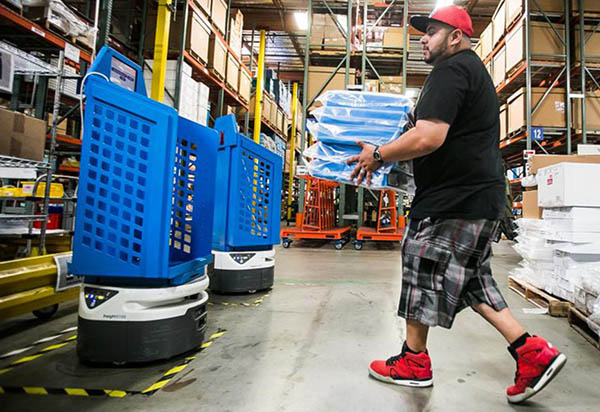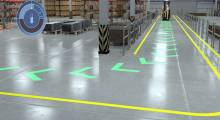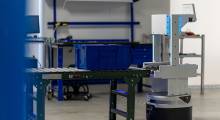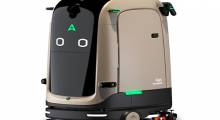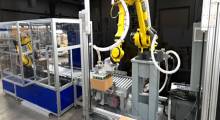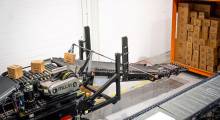Warehouses and distribution centers are looking to optimize efficiency while responding to labor shortages and the boom in e-commerce during the COVID-19 pandemic. New tools are helping to orchestrate people, robots, and critical software for greater productivity. Lucas Systems today said it is partnering with Fetch Robotics Inc. to offer tailored systems for harmonizing warehouse workers with Fetch's autonomous mobile robots, or AMRs.
“The future environment of warehouses and distribution centers will be a mix of people, robots, machines, and systems all working together,” stated Ken Ramoutar, chief marketing officer at Lucas Systems. “The precise orchestration of all the pieces will be key to achieving a competitive advantage in performance.”
Wexford, Pa.-based Lucas Systems provides artificial intelligence-powered voice and optimization software for fulfillment and distribution centers. It said its systems can help companies increase throughput, maintain high worker productivity, and meet accuracy and customer delivery requirements.
People plus robots
“That intersection of how people and robots work together is a hugely important and often-overlooked part of the warehouse automation equation, but it’s where a lot of the unseen value exists,” said Ramoutar.
In combination with Fetch's cloud-based software and AMRs, Lucas said its software can redistribute the division of labor in the warehouse. Robots can handle tasks best suited for machines, freeing staffers to focus on higher-level work, said the company.
For example, in an picking workflow orchestrated by Lucas, a worker could avoid a lot of unnecessary walking by picking items to a tote on a Fetch AMR, directing the robot to a conveyor system to unload, and then triggering another robot to move into place for the worker to continue picking.
“The combination of Lucas’ AI-based warehouse optimization software and Fetch’s broad portfolio of AMRs enables optimized order, batch, case, and pallet picking in distribution centers and automates virtually any manual material movement in a facility,” said Stefan Nusser, chief product officer at Fetch Robotics. “This enables our joint customers to increase picking efficiency, reduce cycle times, and reduce the impact of labor shortages.”
Ramoutar and Barry Phillips, chief marketing officer at San Jose, Calif.-based Fetch Robotics, replied to the following questions from Robotics 24/7:
How does Lucas' warehouse optimization software complement Fetch's existing orchestration systems?
Phillips: Lucas Systems is an established expert when it comes to warehouse optimization. The Lucas Warehouse Optimization Suite of software oversees all the tasks for warehouse workers and optimizes how work is assigned and executed.
For example, Lucas' algorithms minimize the amount of travel workers have to do by intelligently batching work together to minimize worker travel to fulfill orders with maximum efficiency. When Fetch robots are added to the equation, the entire workflow of people and robots is optimized for speed, travel time, and many other changing constraints such as order priority.
Through our ongoing work with Lucas, it has become clear that we can offer customers a powerful solution to improve warehouse productivity and improve the worker experience.
While management of mobile robot fleets is well-understood, how will you manage both people and robots?
Ramoutar: We are working on a variety of worker scenarios of how warehouse workers and robot workers are orchestrated. Take, for example, robots-to-goods, goods-to-person, follow-the-robot, transportation of goods with robots, and full pallet moves scenarios.
Lucas has been developing the algorithms and workflows and performing simulations with Fetch AMRs.
How long do you think it will take to get Fetch's and Lucas' software to work together?
Ramoutar: Lucas and Fetch have been working together for some time, and we have already developed an interface between our systems. As all warehouses have unique requirements, we will continue to build out warehouse scenarios working with customers.
Will warehouse workers be able to direct mobile robots just with voice commands?
Ramoutar: Warehouse workers speak to “Jennifer” through voice commands. Jennifer is the brains and voice of the Lucas system. Workers speak to Jennifer, and Jennifer speaks to them.
Jennifer also orchestrates other resources such as robots. So Jennifer would tell the Fetch robot through the Lucas-Fetch interface when it’s time to perform the next task such as to move to a conveyor to unload or to move to assist another worker.
Lucas Systems has strong voice capabilities that, when paired with Fetch AMRs, enable customers to evolve their warehouse workflows as they deal with growing demands on distribution and fulfillment centers.
How does Lucas Systems deal with noise interference, or is there a microphone that people must use?
Ramoutar: Workers speak to Jennifer through a headset microphone. Lucas has been perfecting its voice technology for over 23 years, so our AI-driven speech engine has been refined to handle noisy warehouse environments, as well as multiple languages.
How will the joint offering be sold—directly, or through third parties?
Ramoutar: We have a flexible model where the joint Lucas-Fetch solutions can be purchased directly or through partner channels, depending on customer preference.
When will the integrated solutions be available?
Phillips: Integrated solutions are available now.
About the Author
Follow Robotics 24/7 on Linkedin
Article topics
Email Sign Up

